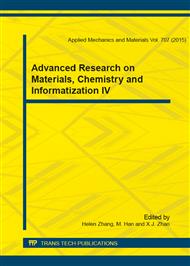[1]
A. Shanian and O. Savadogo. TOPSIS multiple-criteria decision support analysis for material selection of metallic bipolar plates for polymer electrolyte fuel cell. J. Power Sources, Vol. 159 (2006), pp.1095-1104.
DOI: 10.1016/j.jpowsour.2005.12.092
Google Scholar
[2]
H. C. Liu, L. X. Mao, Z. Y. Zhang and P. Li. Induced aggregation operators in the VIKOR method and its application in material selection. Applied Mathematical Modelling, Vol. 37 (2013), pp.6325-6338.
DOI: 10.1016/j.apm.2013.01.026
Google Scholar
[3]
P. Karande and S. Chakraborty. Application of multi-objective optimization on the basis of ratio analysis (MOORA) method for materials selection. Materials & Design, Vol. 37 (2012), pp.317-324.
DOI: 10.1016/j.matdes.2012.01.013
Google Scholar
[4]
A. Kasaei, A. Abedian and A.S. Milani . An application of Quality Function Deployment method in engineering materials selection. Materials & Design, Vol. 55 (2014), pp.912-920.
DOI: 10.1016/j.matdes.2013.10.061
Google Scholar
[5]
A. H. Peng and X. M. Xiao. Material selection using PROMETHEE combined with analytic network process under hybrid environment. Materials & Design, Vol. 47 (2013), pp.643-652.
DOI: 10.1016/j.matdes.2012.12.058
Google Scholar
[6]
P. Chatterjee, V. M. Athawale and S. Chakraborty. Materials selection using complex proportional assessment and evaluation of mixed data methods. Materials & Design, Vol. 32 (2011), pp.851-860.
DOI: 10.1016/j.matdes.2010.07.010
Google Scholar
[7]
L. W. Yang. Projection method for material selection problem with interval numbers. Advanced Materials Research, Vol. 1022 (2014), pp.14-17.
DOI: 10.4028/www.scientific.net/amr.1022.14
Google Scholar
[8]
C. L. Hwang and K. Yoon. Multiple Attribute Decision Making Methods and Applications (Springer, New York, 1981).
Google Scholar
[9]
S. P. Wan. Multi-sensor data fusion based on double base points method. Control and Decision, Vol. 23 (2008), pp.1343-1346.
Google Scholar
[10]
H. X. Pan. Grey target decision-making model based on two-point optimization index weight. Science Technology and Engineering, Vol. 20 (2012), pp.9296-9299.
Google Scholar
[11]
S. Wang, J. Wang, R. J. Zhan and B. Yuan. Risk assessment of aviation equipment development based on combination weighting and double base points method. China Safety Science Journal, Vol. 20 (2010), pp.124-129.
Google Scholar
[12]
W. B. Wang. Core competence evaluation of high-tech corporation based on entropy weight double basis model. Journal of Hunan University (Social Sciences), Vol. 22 (2008), pp.68-72.
Google Scholar
[13]
A. Jahan, M. Bahraminasab and K. L. Edwards. A target-based normalization technique for materials selection. Materials & Design, Vol. 35 (2012), pp.647-654.
DOI: 10.1016/j.matdes.2011.09.005
Google Scholar
[14]
K. R. Sarfaraz, M. B. Dehghan, A. Abedian and R. Mahmudi. A simplified fuzzy logic approach for materials selection in mechanical engineering design. Materials & Design, Vol. 30 (2009), pp.687-697.
DOI: 10.1016/j.matdes.2008.05.026
Google Scholar


